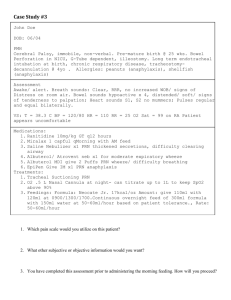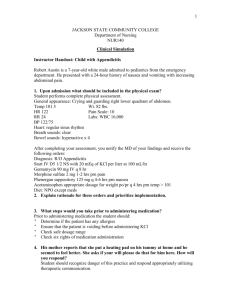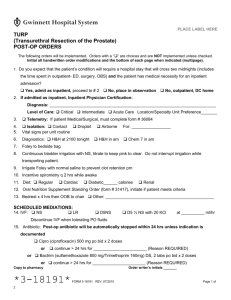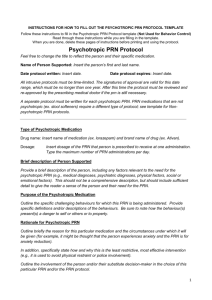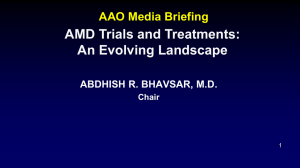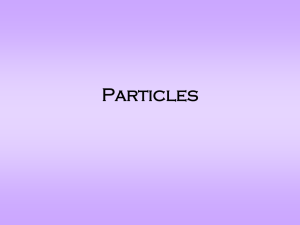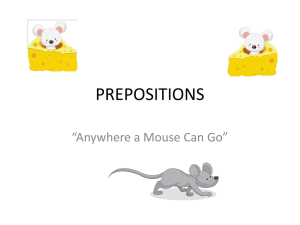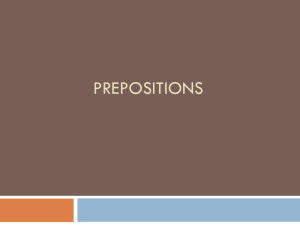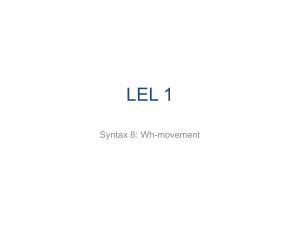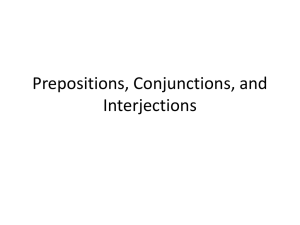Chapter 5 Wh-Movement
advertisement
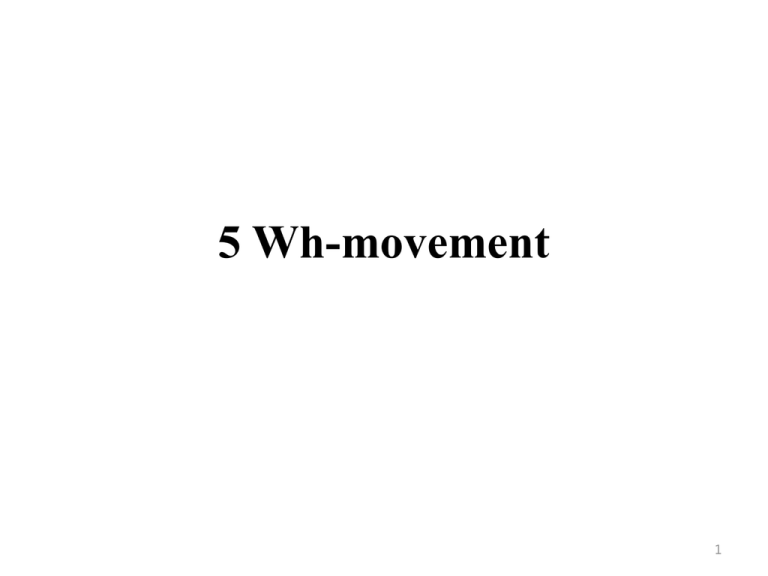
5 Wh-movement 1 5.2 Wh-questions (1) a. What languages can you speak? b. Which one would you like? c. Who was she dating? d. Where are you going? (2) wh-in-situ questions (echo questions in English) a. You can speak what languages? b. You would like which one? c. She was dating who? d. You are going where? in-situ (i.e. ‘in place) 2 Who was she dating? (3) CP Spec Who C´ C T C was + Ø (1) (1) head movement TP PRN T´ she T VP was dating who (2) (2) wh-movement Wh-movement moves maximal projections 3 (5) Complementiser Condition An overt complementiser (like that/for/if) cannot have an overt specifier in the superficial structure of a sentence Cf. wh+that (4) Belfast English (Henry 1995, 107) a. I wonder [which dish that they picked] b. They didn’t know [which model that we had discussed] (5) Standard English a. %I wonder [what kind of party that they have in mind] b.*I wonder [what that they have in mind] 4 Wh-movement: internal merge (Chomsky 2001) • Internal merge: movement operations by which an item contained within an existing structure is moved to a new position within the same structure • External merge: merger operations which involve taking an item out of the lexical array cf. head movement: adjunction operation by which one head is adjoined to another 5 Trace/trace copies in wh-movement • Evidence I - Have-cliticisation (8) I have/I’ve been to Rome more often than I have/*I’ve to Paris (I have been) (9) Cliticisation is barred when a clitic is followed by a null constituent (12) a. I wonder [how much money they have in their bank account b. *I wonder [how much money they’ve t in their bank account] how much money copying & deletion 6 Trace/trace copies in wh-movement • Evidence II - Preposition copying (in relative clause) (14) c. … that fair [for which love groan’d for] (Prologue to Act II. Romeo and Juliet) In present day English: (15) a. but if this ever-changing world [in which we live in] makes you give in and cry, say ‘Live and Let Die’ (Sir Paul McCartney, theme song from the James Bond movie Live and Let Die) b. IKEA only actually has ten stores [from which to sell from] (Economics reporter, BBC Radio 5) 7 - Split / discontinuous spellout (21) What hope of finding any survivors could there be what hope of finding any survivors - Reflexive reading (22) Joe wonders which picture of himself Jim bought (23) Joe wonders [which picture of himselfi [Jimi bought which picture of himself]] 8 5.4 Driving wh-movement & auxiliaty inversion • Edge feature [EF] (26-7) The EF on C enables it to attract the wh-pronoun where to Spec, CP. ‘EF is always deleted when satisfied’ in English. CP PRN/ADV where C´ C TP [EF] PRN Ø you T´ T are VP V going (25) He wants to know [where you are going] PRN/ADV where 9 (24) Interrogative Condition A clause is interpreted as a non-echoic question iff it is a CP with an interrogative specifier (i.e. a specifier containing an interrogative word) (28) Who were you phoning? (29-30) CP PRN who (Merge & Move, and then Delete) C´ C TP [TNS, EF] PRN were+Ø you T´ T were VP V phoning PRN who 10 Null yes-no question particle ‘whether’ Evidence-1: Elizabethan English (32) a. Whether had you rather lead mine eyes or eye your master’s heels? (Mrs Page, Merry Wives of Windsor, III.ii) b. Whether does thou profess thyself a knave or a fool? (Lafeu, All’s Well That Ends Well, IV.v) Evidence-2: yes-no questions introduced by ‘whether ’ in reported speech (33) a. ‘Are you feeling better?,’ he asked. b. He asked whether I was feeling better Evidence-3: yes-no answers (34) a. When he asked ‘Did you vote for L.Loudmouth?,’ I said ‘yes’ and you said ‘no’ b. When he asked whether we voted for L. Loudmouth, I said Evidence-4: can be tagged by or not (35) a. Has he finished or not? ‘yes’ and you said ‘no’ 11 b. I can’t say whether he has finished or not (40) Chain Uniformity Condition A chain is uniform with regard to phrase structure status (Chomsky 1995, 253) (39) *Which have you done [which assignment]? XP X (violates CUC) (37) Which assignment have you done? (41) Attract Smallest Condition/ASC (Pied-piping) (explains 37) A head which attracts a particular type of item attracts the smallest constituent containing such an item which will not lead to violation of any UG principle. = we move wh-word on its own wherever possible, but if it were prevented, then we move the next smallest possible constituent containing the wh-word 12 (44) Economy Condition Derivations and representations…are required to be minimal, with no superfluous steps in derivations and no superfluous symbols in representations. (Chomsky 1989, 69) (47) Left Branch Condition/LBC In languages like English, the leftmost constituent of a nominal expression cannot be extracted out of the expression containing it. (Ross, 1967) Nominal expressions: DP, QP 13 5.6 Pied-piping of a superordinate preposition EF of C triggers mvnt, to Spec-C, of the smallest maximal projection containing WH-word (cf. T in finite clauses carries an EPP feature) (49) They asked [to whom he was referring] (50) PP to whom CP C´ C [EF] Ø TP PRN he T´ T was VP V referring PP P PRN to whom PIC 14 (51) Impenetrability Condition A constituent in the domain of a complementiser or preposition is impenetrable to (and so cannot be attracted by) a higher head ccommanding the relevant complementiser/preposition. prevents ‘preposition stranding’ Cf. (52) They asked [who he was referring to] (53) b. How far did they go inside the tunnel? (54) [PP how far [P´ [P inside] the tunnel]] wh-Spec PP Spec how far P’ P NP PIC inside the tunnel The Impenetrability Condition only bars extraction of a constituent in the domain of (i.e. c-commanded by) the preposition, and the specifier how far is not c-commanded by the preposition inside. => The IPC allows material to be extracted from the edge of a Prepositional Phrase, but not from its (c-command) domain. 15 (52) they asked [who he was referring to] (50) Spec who CP C´ C [EF] Ø TP PRN he T´ T was VP V PP referring PRN P´ who P PRN [EF] who to 16 (57) What might he think that she is hiding what? (63) CP Spec C´ what C TP might+Ø PRN T´ he T VP might V CP think PRN C´ what C TP that she is hiding what 17 (57) What might he think that she is hiding what? (63) CP Spec C´ what C TP might+Ø PRN T´ he T VP might V CP think PRN C´ what C TP that she is hiding what 18 Quantifier stranding/floating McCloskey (2000, 2002) (64) What all did you get for Christmas? =‘What are all the things which you got for Christmas?’ (65) a. What all do you think that he’ll say that we should buy? b. What do you think all that he’ll say that we should buy? c. What do you think that he’ll say all that we should buy? d. What do you think that he’ll say that we should buy all? (66) [CP What all [C that] we should buy] 19 5.8 Multiple wh-questions (76) a. He might think that who has done what? b. Who might think that he has done what? c. *What might he think that who has done? d. *Who what might he think that has done? e. *What who might he think has done? (78) Attract Closest Condition A head which attracts a given kind of constituent attracts the closest constituent of the relevant kind. (79) Wh-Attraction Condition The edge feature on C attracts the smallest possible maximal projection containing the closest wh-word to move to spec-C 20 (76) c. Who might he think has done what? (82) CP Spec who C C´ TP [TNS, EF] PRN might+Ø he T´ T VP might V CP think PRN C´ who has done what 21
